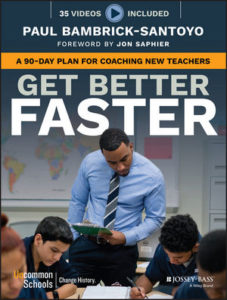Posts Tagged ‘Paul Bambrick-Santoyo’
5 Strategies for Scaling Effective Coaching
Our team spends a lot of time thinking about how to develop teachers. We believe that investing in the professional growth of teachers has the potential to dramatically change the landscape of education in our country and the lives of millions of children. While school systems across the U.S. spend billions of dollars annually on teacher professional learning and development we have little proof of their efficacy (The Mirage, TNTP 2015).
Given this context, we were thrilled to read a new study, The Effect of Teacher Coaching on Instruction and Achievement by Matthew Kraft and Dylan Hogan of Brown University and David Blazar from Harvard University. Kraft and his team conducted a meta-analysis of 37 studies and found coaching programs to positively impact instruction (.57 standard deviations) and student achievement (.11 standard deviations). The authors offer the following summary:
The results of our meta-analysis suggest that teacher coaching programs hold real promise for improving teachers’ instructional practice and, in turn, students’ academic achievement. These findings provide strong motivation to invest in efforts to scale up teacher coaching models, and to expand and improve upon the existing research base.
Effective Coaching
The authors characterize the coaching process as one where instructional experts work with teachers to discuss classroom practice in a way that is:
- Individualized: one-on-one sessions
- Intensive: frequent interaction between teachers and coaches (e.g., at least every couple of weeks)
- Sustained: coaching support over an extended period of time
- Context-specific: coaching on their practices within the context of a teacher’s classroom
- Focused: teachers and coaches engage in deliberate practice of specific skills
These findings support much of the work we have done with school systems including KIPP Austin Public Schools, DREAM Charter School and the Cleveland Metropolitan School District to grow talent through multiple-measure evaluation and development frameworks. Each of these organizations have employed innovations specific to their unique contexts, however common across all approaches is a theory of change that recognizes the critical role coaches play in moving teacher practice and ultimately student outcomes.
Scaling Systems of Effective Coaching
One of the most important insights in the analysis is data suggesting “that coaching can have an impact at scale” but that scaling-up programs (to more than 100 teachers) is challenging, particularly in building a cohort of capable coaches and in establishing strong teacher buy-in.
From our experience, these two factors matter mightily. There are certainly pockets of excellent coaching in every school system, but the real challenge of scale is consistency of implementation. Here are five strategies for solving the scale-up challenges described by Kraft, Blazar and Hogan:
1. Establish a common definition of excellence: Coaching is incredibly hard work as it requires deep content knowledge, pedagogical expertise, emotional intelligence and strong interpersonal communication skills. One the best steps we can take to set coaches up for success is adoption of a clear definition of excellent teaching (e.g., a robust rubric or vision of excellence document). In establishing a common bar of quality of important instructional practices and a common language, coaches and teachers have a clear development road-map to work along. You can read more about strong observation rubrics in this March 2017 post.
2. Make Tools Available: Great coaches need tools to guide their learning and development. School systems should develop and train leaders on a common observation debrief protocol or conversation guide such as Paul Bambrick’s 6-Steps to Effective Feedback or the TEF Debrief Planning Guide to structure coaching conversations. Systems for capturing, analyzing and sharing observation data including observation ratings and feedback are also vital for supporting coaching efforts.
3. Invest in ongoing leader development: Often lost in conversations around teacher professional development is the importance of ensuring professional learning for those responsible for coaching teachers. These professionals warrant the same level of thoughtful support. Summer is a great time to bring coaches together for intensive training but without ongoing follow-up, development can be lost or minimized. Managers of coaches should have talent development within their core responsibilities including time for managers to observe and support school leaders/coaches working with their teachers.
4. Build a Culture of Transparency and Continuous Improvement: Ultimately the work leaders do coaching teachers is only as impactful as the level of trust and partnership teachers feel in the relationship. Transparent communication of the “why” and “how” of key policies along with timelines, goals, and progress to-date is essential for successful long-term investment. Gathering frequent feedback with public recognition of the findings and appropriate next steps will build a culture of continuous improvement.
5. Phase-in implementation: As noted in the study, working one-on-one with any person over a sustained period requires an investment of time and money. Certainly shifting funds from less effective professional development activities toward coaching is a strong first step. Another strategy is to phase-in implementation of a coaching program to build capacity, gain early wins, expand the coalition of supporters, and prove the value of the financial investment. We suggest system leaders identify the core problem they are hoping to solve, then target the first phase of implementation toward that issue. For example, if a system seeks to solve the challenges that arise from new teachers lacking foundational classroom management skills they can launch a coaching program focusing on that subset of teachers. Over time, coaches could roll-off and target other groups of teachers for support or the program could expand with the hiring of additional coaches.
What approaches to coaching teachers have you seen work well? How have you built a cohort of strong coaches and/or invested teachers? Let us know in the comments below!
Coach's Corner: Book Review of Get Better Faster
We  all know that teaching is hard, but being a new teacher can sometimes seem downright impossible. Fortunately, Paul Bambrick-Santoyo has laid out a critical tool for driving the professional growth of new teachers in his latest book, Get Better Faster: A 90-Day Plan for Coaching New Teachers.
all know that teaching is hard, but being a new teacher can sometimes seem downright impossible. Fortunately, Paul Bambrick-Santoyo has laid out a critical tool for driving the professional growth of new teachers in his latest book, Get Better Faster: A 90-Day Plan for Coaching New Teachers.
The Chief Schools Officer for High Schools and K-12 Content Development at Uncommon Schools, Bambrick-Santoyo has become a leading figure in school leadership, professional development, and data-driven instruction. In Get Better Faster, Bambrick-Santoyo lays out a compelling case for how school leaders, administrators, and coaches can guide new teachers to develop their instructional practice efficiently and effectively, making an immediate impact on the lives of their students.
In focusing on new teacher quality, Bambrick-Santoyo recognizes the immense power teachers have in shaping the lives of their students as well as the corresponding responsibility for coaches to guide their teachers to success. Across the nation however, Bambrick-Santoyo notes:
Teachers aren’t receiving much coaching. As a consequence, educators are very rarely asked to practice the micro-skills that will make them better at teaching–especially not under the supervision of an expert who can help them get better on the spot. Unlike soccer players, actors, or doctors, teachers tend to have to learn on their own.
It should be as no surprise to know that many U.S. teachers leave the profession within their first few years of teaching, often in response to the lack of support needed to feel and be successful.
Get Better Faster is built off of the guiding concept that what is actionable is “practice-able” and therefore able to respond to effective coaching.
Bambrick-Santoyo begins by identifying and unpacking three core principles of coaching:
- Go Granular: break teaching down into discrete skills to be practiced successively and cumulatively.
- Plan, Practice, Follow Up, Repeat: Coach a teacher through effective practice.
- Make Feedback More Frequent: Make the most of every observation by increasing the frequency of feedback.
The text then moves into a detailed scope and sequence for rapidly improving teacher practice. Bambrick-Santoyo outlines how to support teachers with classroom management and rigorous instruction by identifying a prioritized list of key action steps with guidance on when to use the strategy, what it looks/sounds like, and scenarios for practicing. For example, the scope and sequence for classroom management begins with “routines and procedures 101” then scaffolds up to using a “strong voice”, giving clear directions, and actively scanning the room. For instructional rigor, the sequence guides leaders through coaching on lesson planning, use of exemplars, meaningful independent practice and methods for checking for understanding.
Like his prior publications, Get Better Faster is full of strong real-classroom examples, recommendations for implementation, printable resources and a thorough video library of great coaching in action. Leaders across the country working with new teachers will be well-served by the expertise Bambrick-Santoyo has captured in this book and many students will be grateful for their doing so.
We have used the concepts and resources in Get Better Faster throughout our work with many clients including the Cleveland Metropolitan School District, New York City Department of Education, and DREAM Charter School. For more information about those projects, visit http://hendyavenue.com/clients/.

